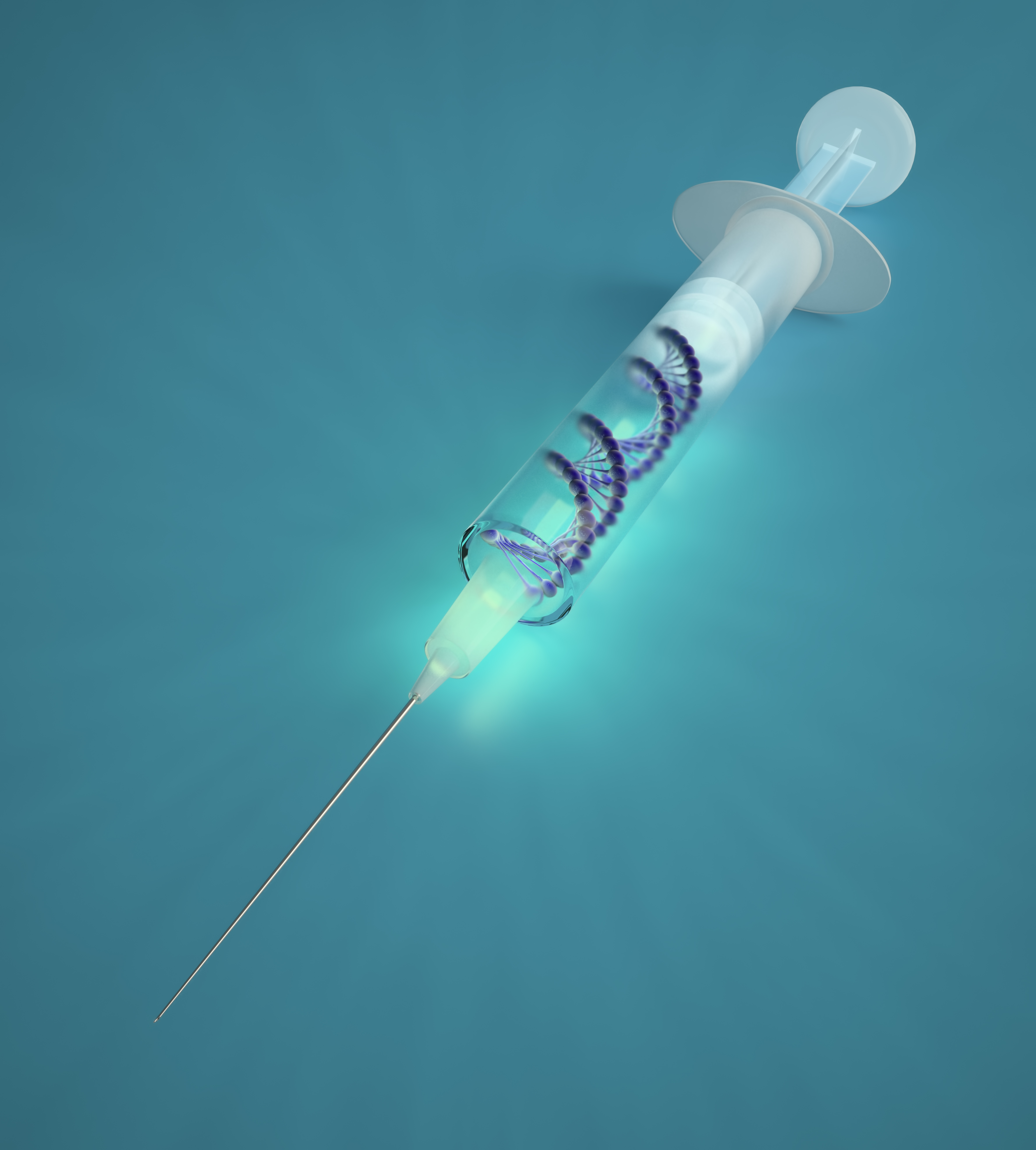
Unpacking recent gene therapy press
Voyager Therapeutics is shifting towards a new technology to deliver gene therapy and away from a planned HD clinical trial. But this could lead to less invasive drugs in the long run, and many other companies are working on HD gene therapies.


A recent announcement from Voyager Therapeutics outlined a shift in the company’s strategy towards an exciting new technology for gene therapy delivery. Unfortunately this also means that in the short term, they have dropped previous plans to test an HD gene therapy in people with HD. While this news is disappointing, the decision to embrace a novel approach now could potentially lead to a safer, more accurate, and less invasive HD therapeutic in the longer term.
This news provides an opportunity for the HDBuzz team to talk more about the current landscape and share the latest news from the gene therapy pipeline.
A brief genetics recap
Before we get into the HD gene therapy pipeline, let’s review some basic genetics. With the advent of RNA-based COVID vaccines, we’ve all been hearing a lot about RNA. But how does RNA differ from DNA, and what does it mean if we alter either of these?

You can think of DNA like a blueprint – it’s the master plan at the genetic level for every cell in your body. To ensure that master plan stays in pristine condition, cells make copies of DNA to work from when they make proteins. That copy of the DNA is RNA. Because RNA is just a copy, it can be well-used without much care if it gets a bit tattered. If it does, the cell can just make another RNA copy from the DNA blueprint, and voila! The cell has a fresh RNA copy that can be used to produce more protein.
Scientists have leveraged this knowledge to come up with clever ways to get cells to produce more or less of the proteins they’re interested in.
Applying this to huntingtin-lowering
In the case of Huntington’s disease, we’re interested in reducing production of the huntingtin protein that damages cells – referred to as huntingtin-lowering. That could be done in 2 ways:
1) Destroy the RNA copies as they are produced, but leave the DNA blueprint intact. This is the strategy behind antisense oligonucleotides (ASOs), like those that were being tested in trials by Roche and Wave.
2) Modify the message of the DNA blueprint, so it either can’t be copied into RNA or contains new instructions to help destroy the RNA. This approach is what we refer to when we say “gene therapy” – it changes what is made from the blueprint without altering it.
While both of the strategies above ultimately lower huntingtin protein production, they are different for several reasons. The primary difference is that destroying only the RNA copy requires repeated doses. Because the cell still has the original DNA blueprint for the huntingtin protein, it will continue to make more RNA copies. So unless the copy is constantly destroyed, the huntingtin protein will still be produced. While the repeated doses may seem like a nuisance, this type of approach means that the effect of any drug that targets only the RNA will eventually wear off – an added safety benefit.
Gene therapy approaches for huntingtin-lowering, like those being pursued by uniQure and Voyager, target huntingtin with a one-time delivery of genetic instructions to cells of the brain. These instructions then tell the cells to continuously produce RNA molecules that can interfere with the making of huntingtin, leading to lower protein levels. This is a one-and-done type of approach – no repeated doses necessary. But something to consider is that this approach also means that if there are other effects because of huntingtin-lowering, there’s no going back.
It’s important to note that even though DNA is being added in these gene therapy approaches, a person’s DNA is not being edited. This means that while the gene therapy will have benefits in the person being treated, it won’t be passed to future generations. That would require a gene editing strategy like CRISPR.
“The announcement had a lot of corporate and investor information, but the science content centered around an improved gene therapy delivery system and a proprietary discovery platform, which in combination could allow Voyager to develop less invasive methods of delivering gene therapies for rare diseases like HD. ”
Current gene therapy strategies for brain diseases like HD would require brain surgery since these DNA-altering drugs can’t get past the barrier of the brain. This major limitation is something Voyager wanted to get around.
What did Voyager share?
On August 9th, 2021, Voyager Therapeutics issued a press release about their finances, recent leadership transitions, and importantly, a major shift in their scientific pipeline. The announcement had a lot of corporate and investor information, but the science content centered around an improved gene therapy delivery system and a proprietary discovery platform, which in combination could allow Voyager to develop less invasive methods of delivering gene therapies for rare diseases like HD.
Like previous genetic therapies developed by Voyager (and other companies, like uniQure), delivery involves packaging genetic drugs inside a harmless virus called an AAV. In the field of HD gene therapy, AAVs are used to deliver genetic instructions that cause cells to divert one tiny wing of their machinery towards producing a genetic “antidote” to the expanded HD gene.
Voyager has developed a proprietary new AAV packaging and has collected evidence from monkeys that these AAVs can be delivered with greater safety, potency, and accuracy. They have also invested in a new discovery system for identifying and improving upon AAVs for additional diseases and drug targets.
What does this mean for HD gene therapy?
Whereas AAV delivery of HD therapies has so far required a brain surgery, drugs developed using Voyager’s new platform can be designed for delivery through an injection into the blood, so there is potential for less invasive delivery to the brain.
The press release shared that Voyager will shift its focus to the new technologies and away from older existing ones. The upside is the next-generation technology; the downside is that this means that Voyager will no longer be pursuing the therapy that they had previously developed for HD. This drug, VY-HTT01, was meant to be the focus of a planned clinical safety trial called VYTAL, which would have begun later this year. No participants had yet been recruited – it was still in early planning stages.
Although the loss of a gene therapy that was approaching the clinic is a significant short-term setback, Voyager’s shift in focus now to accommodate a new scientific development provides a new and potentially better therapeutic avenue for HD.

Other gene therapies in the pipeline
Luckily, there are other companies working on gene therapy approaches, who have also provided recent public updates on their ongoing or upcoming trials for Huntington’s disease. We’ve provided brief summaries for each of these below; stay tuned for additional updates as these efforts advance.
The first company out of the HD gene therapy gate was uniQure, who are developing a viral therapy known as AMT-130, which has the goal of delivering instructions to brain cells for the making of a special kind of RNA that will find and destroy the RNA for the huntingtin gene. In this way, gene therapy can be used to permanently induce huntingtin-lowering. After many years of careful work in animals, uniQure launched their safety study, and as of this summer they have excitingly been able to complete surgeries for 12 of the planned 26 patients. A strictly regulated schedule has allowed the team to carefully monitor any safety worries, and none have emerged so far.
Additional companies in the preclinical stages of development of virus-based huntingtin-lowering gene therapies include Spark, Sanofi, and AskBio.
Another gene therapy approach to huntingtin-lowering relies on a novel tool known as a Zinc Finger. We’ve been writing about this approach at HDBuzz since 2012, and more recently (2019) about a large scale study of the tools in HD mice. Recently, the Japanese drug company Takeda has taken over the HD program from Sangamo Therapeutics, who initially developed the drugs. A key benefit of the Zinc Finger approach for huntingtin-lowering is that it allows selective silencing of just the mutant huntingtin gene, while sparing the normal copy that nearly every HD patient has.
Strategies that target the RNA copy
We mentioned the multiple-delivery strategy which was used by Roche and Wave in the trials that concluded unsuccessfully this spring. Despite these setbacks, ASOs and other RNA-based strategies are still being actively developed as HD therapies.
Wave Life Sciences has redesigned the chemistry of their ASO drugs, which could lead to better potency and the ability to use lower doses in people with HD. They have announced plans to launch a safety trial of a new ASO by the end of 2021. The drug is called WVE-003, and it targets the expanded form of huntingtin.
Novartis and PTC Therapeutics are developing drugs called splice modulators that also target huntingtin RNA, but can be delivered by mouth. We covered Novartis’s drug, branaplam, in a recent article; a trial in HD patients is planned to begin by the end of 2021.
“The extensive efforts from other companies in the gene therapy space and beyond suggest that a lot of really exciting strategies are being applied to the problem of HD. ”
NeuBase Therapeutics is developing an ASO drug called NT0100 which also aims to target only the expanded form of huntingtin.
At the end of July, a company called Vico Therapeutics received a special rare disease therapeutics status, known as Orphan Drug Designation, to develop their ASO for HD, known as VO659.
Companies like Atalanta and Alnylam/Regeneron are developing ways to lower huntingtin through RNA interference (RNAi) which, similar to ASOs, target copies of RNA and would require multiple deliveries.
Even more approaches
There are more strategies in the works, some of which also rely on gene therapy or destroying copies of RNA, like targeting the expansion of CAG repeats, which is being explored by companies like Triplet Therapeutics and LoQus23 Therapeutics.
There are also many approaches to HD drug development that diverge from genetics but focus on addressing other aspects of HD biology, like preserving or boosting connections between neurons, or treating aggression, memory issues, or movement problems. Those already being tested in human we explored in a recent clinical trials roundup. Other companies have pre-clinical programs aimed at strategies like cleaning up existing huntingtin protein that litters brain cells, suppressing inflammation in the HD brain, and more – newcomers to HD research are quite frequent (and very welcome)!
Take Home Message
Gene therapy for brain diseases is amongst the most cutting edge approaches to trying to fight HD. As with any new field, there are bound to be many ups and downs on the way to a treatment. The recent update from Voyager is a good example of this – while it’s disappointing that they’ll not be running their planned trial later this year, it’s very exciting that they’ve developed these new technologies and want to apply them to help HD families. The extensive efforts from other companies in the gene therapy space and beyond suggest that a lot of really exciting strategies are being applied to the problem of HD.
Learn more
Sources & References
For more information about our disclosure policy see our FAQ…


